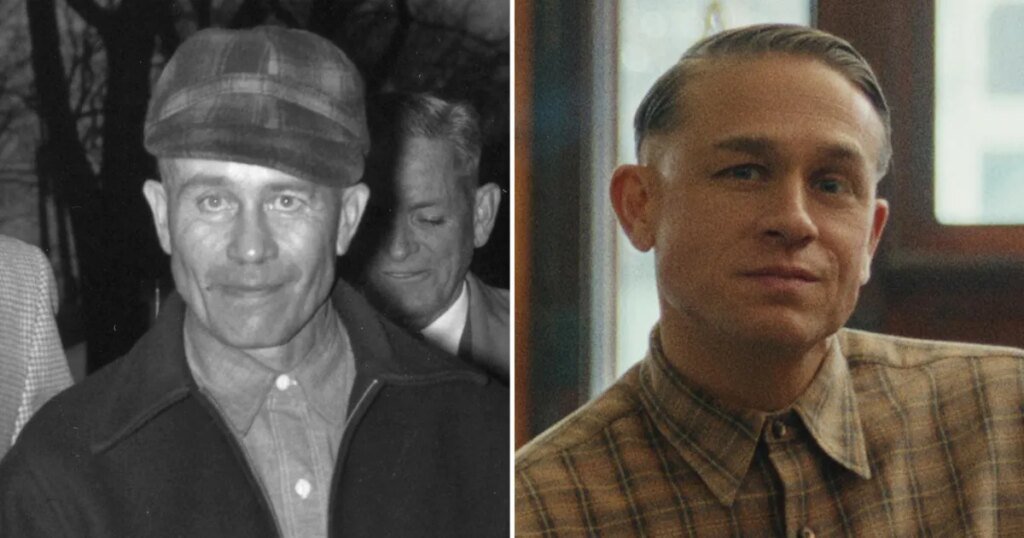
Unpacking the Inaccuracies of Monster’s Ed Gein: Murder Case Insights and Necrophilia Details
Ryan Murphy‘s Netflix series Monster has faced criticism in the past for its inaccuracies regarding its subjects — but what did the series get wrong about Ed Gein’s story?
The first season of this scripted true crime series premiered in 2022, highlighting Evan Peters’ portrayal of Jeffrey Dahmer. Monster, which also featured Niecy Nash, came under scrutiny when families of Dahmer’s victims disclosed that they were not consulted for the show.
Season 2 encountered similar backlash when Erik Menendez criticized Murphy’s depiction of him and his brother Lyle Menendez. Nevertheless, Murphy stood by his work, asserting that Monster reignited support in the Menendez case. Although Erik and Lyle were denied individual parole requests, they later retracted their public disapproval of the show—except for the incest suggestions.
Murphy ultimately selected Ed Gein as the focus for the third season. Portrayed by Charlie Hunnam, this season delved into how Gein became a convicted murderer, suspected serial killer, and grave robber. It also examined how Gein’s heinous acts contributed to the evolution of true crime as a pop culture phenomenon, influencing works like Psycho, The Texas Chainsaw Massacre, and The Silence of the Lambs.
“This whole series shines a light on us,” showrunner Ian Brennan told Tudum in October 2025. “It’s crucial to pay attention to the images and narratives we consume. They linger with us and have a profound impact.”
Hunnam articulated the core message of Monster, stating, “Who is the real monster? The tormented boy who lived a life of abuse and isolation, suffering from untreated mental illness? Or the multitude who sensationalized his existence for entertainment, thereby embedding darkness into the American and global psyche?”
However, to underline Gein’s crimes—and their societal impact—Monster made several alterations.
Monster is currently streaming on Netflix. Continue reading for a detailed examination of the inaccuracies and adaptations the show employed to create the series:
Ed Killing His Brother
The season premiere depicts Ed engaging in a confrontation with his brother Henry Gein (Hudson Oz), resulting in a blow to Henry’s head. Despite Henry’s accidental death in 1944, Ed attempted to conceal it, making it appear as though his brother died post-brush fire.
Henry’s official cause of death was asphyxiation leading to heart failure. He had head bruises, yet no autopsy was performed, and foul play was not suspected until Ed’s arrest in 1957.
Ed, who discovered his brother’s body, never confessed to involvement in Henry’s death—whereas Monster asserted he was responsible.
The Existence of Adeline Watkins
Throughout the season, Ed was depicted as being involved with neighbor Adeline Watkins (Suzanna Son), the two even becoming engaged. They encountered several challenges, including Watkins’s temporary relocation to New York, but she ultimately did not remain with Ed. Watkins allegedly introduced Ed to grave robbing and later distanced herself from his violent tendencies once he was arrested.
However, the actual Watkins clarified in a contemporaneous interview that claims of a two-decade relationship were inaccurate. She stated that they only met in 1954, well after Ed had begun his disturbing behaviors. Watkins claimed their contact lasted only about seven months, during which she never visited his home or knew of his crimes.
Brennan told Tudum that the show utilized the real Watkins as a launching point for the narrative.
“[What] we do know is that she initially presented their relationship as serious, then later denied it,” he added. “We were unsure whether Watkins genuinely existed in the show’s context or was merely a figment of Ed’s imagination intended to guide his storyline.”
Various Other Crimes
In reality, Ed confessed to the murders of two women: tavern owner Mary Hogan in 1954 and hardware store owner Bernice Worden in 1957. He was suspected of additional crimes in his Plainfield, Wisconsin, hometown, including exhuming multiple graves and crafting grotesque keepsakes from the bodies.
Netflix’s Monster expanded on Ed’s potential offenses by depicting a traumatic babysitting job that ended with him taking the children to his home of horrors. He subsequently murdered their usual babysitter, Evelyn (Addison Rae), which veered into fictional territory, although Rae portrayed a real woman named Evelyn Hartley, whose disappearance remains unsolved. The series also included missing hunters Victor Travis and Raymond Burgess, who disappeared around the same time.
His Interest in Ilse Koch
Much of Ed’s fascination with skinning his victims allegedly stemmed from his exposure to Holocaust survival stories. The Netflix series specifically identified Ilse Koch — a genuine war criminal from the Holocaust — as an influence on Ed. While both Koch and Ed became infamous for crafting furniture from human remains, there is no solid evidence that Ed was directly inspired by Koch’s crimes.
Watkins, who introduced Ed to graphic Holocaust imagery, was intended to be the link between them, though this connection may have simply served to intertwine various storylines in the show.
The Use of a Chainsaw
Promotional materials and specific scenes in the series link Ed to a chainsaw. In reality, the criminal shot his first victim, while the second was dismembered without a chainsaw. This addition alludes to Ed’s influence on the killer in The Texas Chainsaw Massacre.
The Ham Radio
Ed was initially deemed unfit for trial and was sent to a mental health facility. In 1968, a judge ruled him competent to stand trial, and he was found guilty of the murder of Worden. Subsequently, he was determined to be legally insane and remained in a psychiatric institution until his death in 1984 from respiratory failure due to lung cancer.
While in the psychiatric facility, Ed had access to a ham radio. However, Monster depicted fantastical scenarios of Ed communicating with Koch and Christine Jorgensen (Alanna Darby), one of the first individuals to undergo sex reassignment surgery in the U.S.
There is no evidence that Ed ever spoke with Koch or Jorgensen. Murphy and Brennan discussed the ham radio “gimmick,” explaining to Tudum, “[We thought,] this is a perfect way to dramatize his relationships with all of those women and have those conversations catalyze his realization of who he was, what he did, and their influence on him.”
Details of Ed’s Crimes
After his arrest, Ed claimed he did not engage in sexual acts with the corpses he exhumed due to the odor. Monster took a decisive turn from this narrative, depicting in graphic detail how Ed would have relations with cadavers.



